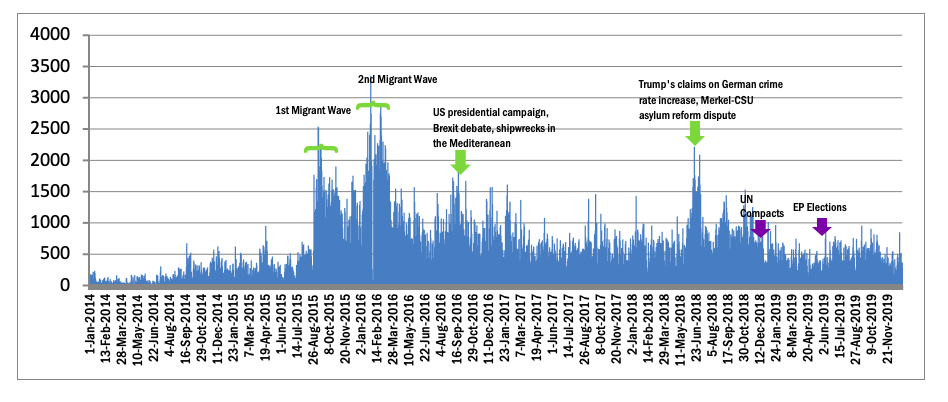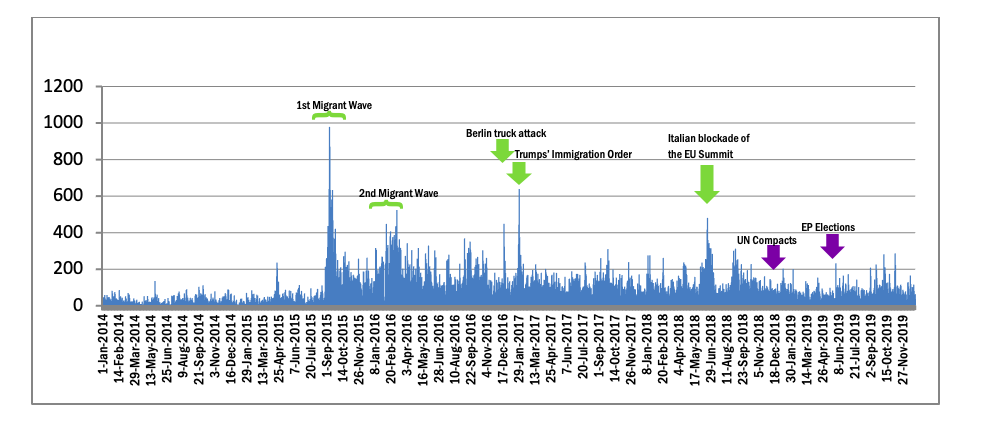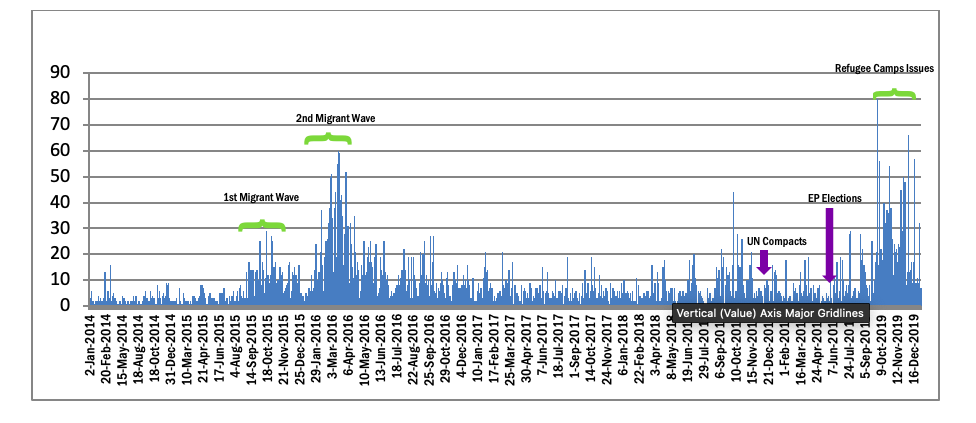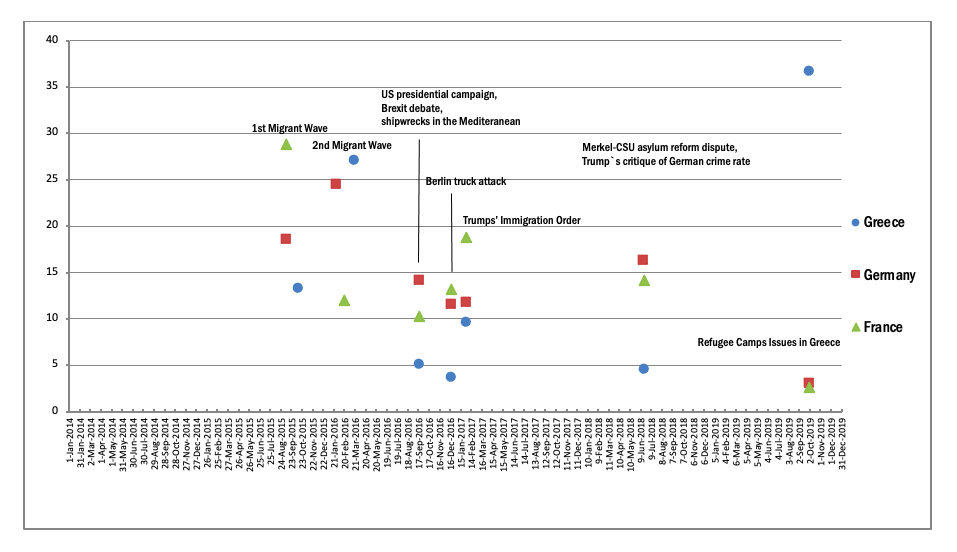Weighting the Crisis: Comparing Media Coverage of Migration-Related Events in the EU
By Slavko Splichal and Boris Mance, the University of Ljubljana
The migration crisis proved to be not only one of the biggest humanitarian catastrophes of the past decade in Europe but also one of the most salient media-covered eventsi. But when comparing the media coverage of migration-related issues and events in the aftermath of the crisis, some national idiosyncrasies are revealed – particularly between countries at the EU’s external borders and central European countries. Below we present some preliminary data from PROTECT’s media research.
In September 2015, there was probably not a single country in the EU that was not affected by the so-called first migration wave, which earned the common denominator of the ‘European crisis’.
The events that accompanied the influx of people from the Mediterranean coast and across the Balkan route to Pas-De-Calais and the Munich train station became a dominating topic in the media across Europe.
The data presented in Figures 1-3 below highlights three aspects of the European media coverage of the migration influx:
– Events related to the large influx of people into the EU in 2015 and 2016, labelled as the 1st and 2nd migration waves in the figures below, received relatively high attention in the media of the three EU countries analysed;
– Events in countries located at the EU’s external border, such as Greece, received even higher attention in the Greek media, but did not resonate in the media of EU central countries, such as Germany or France;
– Media coverage of highly prominent political events, such as the UN International Compact on Regulation adopted in Marrakech in 2018 or the European Parliamentary Election Campaign in 2019, received relatively low media coverage when compared to other prominent events related to the issues of migration.
This blog presents and compares news coverage of migration-related events from France, Germany and Greece from 2014-2019.
The insights presented in this blog are based on data from the global media monitoring platform Eventregistry, which collects news articles from over 150,000 news sources published worldwide in over 40 different languages.

Figure 1: Frequency distribution of migration-related new stories in German media, 1.1.2014 – 31.12.2019 (number of news outlets = 711; number of articles 1,276,351). Copyright: PROTECT

Figure 2: Frequency distribution of migration-related new stories in French media, 1.1.2014 – 31.12.2019 (number of news outlets = 595; number of articles 219,148). Copyright: PROTECT

Figure 3: Frequency distribution of migration-related new stories in Greek media, 1.1.2014 – 31.12.2019 (number of news outlets = 151; number of articles 11,500). Copyright: PROTECT
Two waves – several co-occurring crises
In the media in all three countries presented in Figures 1-3 above, we can observe somewhat variable but frequent reporting of migration-related developments.
However, when studying the news peaks that the first and second wave created, it is crucal to consider them as aggregations of several simultaneous events:
The peak of reporting in September 2015, for example, includes reporting on raids at the Greek-Macedonian border and subsequently on the Serbian, Croatian and Hungarian borders.
This peaks also includes the death of Aylan Kurdi, the toddler whose photo circulated worldwide and became a symbol of the humanitarian crisis taking place in the EU.
The peak around March 2016 was generated by the debates framing migrations with the Syrian war and the EU-Erdogan agreement.
Deporting the Crisis to the Greek Islands
While migration issues appear to be less visible in the news coverage of central EU countries in 2018-2019, this does not apply to all EU countries.
In countries at the EU’s external border, such as Greece, events related to migration became highly salient in the later analysis period, even higher than events in 2015 and 2016.
In the Greek media, the most reported events in the autumn of 2018 and 2019 were related to migration, especially the atrocious situation in refugee camps.
Amnesty International Secretary-General Kumi Naidou’s called for the relocation of refugees from the island to the mainland and the debate on permanent residence permits offered to refugees, the distribution of EU aid to refugees residing in Greece.
However, media reporting on all these events seems to have been limited by national borders and did not receive similar attention from journalists in the media of the central EU countries analyzed.
Media Ignorance of Multilateral Political Debates?
Although migration-related events strongly encouraged far-right movements across Europe, the issue was less prominent in the European Parliament’s election campaign: its visibility (at least in the countries analyzed) was significantly lower than at the beginning of the period under analysis.
Moreover, events concerned with international solutions, such as the adoption of the Global Compacts on Migration and Refugees, were significantly less emphasized in the media.

Figure 4: Relative significance of major migration-related “events” constructed by the German, French and Greek media (as a percentage of the sum of the frequencies of all articles on the selected seven most salient events per country). Copyright: PROTECT
Neutralisation or Disintegration?
Our data indicate that the frequency of migration-related news decreased in central European countries in the latter period of analysis, compared to 2015 and 2016.
Meanwhile, the issues only amplified in salience at Europe’s periphery.
The statement of the EU leadership that ‘Europe is no longer experiencing the migration crisis we lived in 2015, but structural problems remain’[i], suggests that the European migration crisis should be conceived, in Sewell’s conceptualization, as ‘sequences of occurrences that result in transformations of structures’ (1996, 843)[ii], which ‘begin with a rupture – a surprising break with routine practice’ (ibid.), followed by attempts for its neutralization and reabsorption into pre-existing structures.
The importance that news outlets attribute to certain events as part of their gate-keeping and agenda-setting decisions helps to increase public perception of the importance of an event or issue.
Unfortunately, it seems that the structures from Europe’s center – with their media looking away – have relocated the burden of the reabsorption to the countries at the periphery.
Also watch:
Anamaria Dutceac Segesten presents some initial findings from PROTECT’s research on social media discourses on migrants and refugees:
[i] https://ec.europa.eu/commission/presscorner/detail/en/IP_19_1496
[ii] https://link.springer.com/article/10.1007/BF00159818
